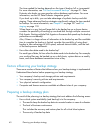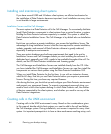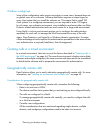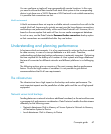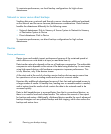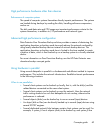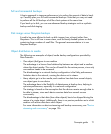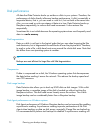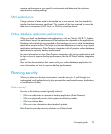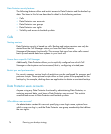You can configure a single cell over geographically remote locations. In this case,
you need to ensure that data transfer from each client system to the corresponding
device is not done over a WAN. Because a WAN network is not a stable connection,
it is possible that connections are lost.
MoM environment
A MoM environment does not require a reliable network connection from cells to the
central MoM cell, because only controls are sent over the long distance connections,
and backups are performed locally within each Data Protector cell. However, this is
based on the assumption that each cell has its own media management database.
In such a case, use the Data Protector Reconnect broken connections backup option
so that connections are reestablished after they are broken.
Understanding and planning performance
In business-critical environments, it is a key requirement to minimize the time needed
for data recovery in case of a corrupt database or a disk crash. Therefore,
understanding and planning backup performance is extremely important. Optimizing
the time required for the backup of a number of client systems and large databases
that are all connected on different networks and different platforms is a challenging
task.
The following sections give an overview of the most common backup performance
factors. Due to the high number of variables it is not possible to give distinct
recommendations that fit all user requirements.
The infrastructure
The infrastructure has a high impact on the backup and restore performance. The
most important aspects are the parallelism of data paths and the use of high-speed
equipment.
Network versus local backups
Sending data over a network introduces additional overhead, as the network becomes
a component of performance consideration. Data Protector handles the data stream
differently for the following cases:
• Network datastream: Disk to Memory of Source System to Network to Memory
of Destination System to Device
• Local datastream: Disk to Memory to Device
Concepts guide 67




